Thursday, July 13 – Sunday, July 16, 2023: Countless mountains, 8000 rubber ducks and one old bus!
Info:
From Dawson City, the Top of the World Highway leads to the 1258 m high border crossing into Alaska and on until it joins the Taylor Highway just before the “town” of Jack Wade. From Tok we take the Alaska Highway to Fairbanks.
Fairbanks is a city of 32,500 people located on the Chena River on a plain at 136 meters above sea level. In the distance, the mountains of the Alaska Range can be seen.
My opinion:
Yipiiiieh! I made it to Alaska!
Diary:
When I woke up on the morning of July 13, I heard the familiar sound of rain as it fell on Annie Way’s roof. The next moment I was sitting bolt upright in bed. Rain.
Rain! We wanted to drive the Top of the World Highway that day! The weather app showed a completely new picture that was strikingly different from the previous day’s forecast. Rain.
Also in Fairbanks: rain.
And in Tok: Rain.
Damn!
Sally looked at me with a grin, Leopold trusting as always. That was no help either. Hilde seemed a little worried. Leona remained silent.
Given the weather and my annoying cold, I made at least one decision: no shower. For someone who had trudged through the snow in Jasper with wet hair (without catching a cold!), this was unusual. But still. The first decision was made.
The second was due. To drive or not to drive? I thought of the highway heroes of Dawson Creek. Definitely not in the rain. All the people I had talked to in Dawson, and who had come from Fairbanks, had said: No way in the rain! On the other hand, Ukjese in Carmacks had meant that it could be done.
Not showering and not driving – that would have been a little too much cowardice for one day. The decision was: try it! With the option to simply turn back if it became too dangerous for me.
I ate a hearty breakfast (four mini cinnamon rolls instead of the usual two) because you had to figure seven to eight hours for the Top of the World Highway. Annie Way’s refrigerator was stocked with delicious vegetable samosas from the Dawson Grocery Store, among other things. These were going to be my first meal in the US. If possible in an idyllic place with a view of mountains and the endless vastness. That’s how I had imagined it. Yesterday. Before the rain.
So off we go: things lashed down in the storage space. Propaine turned off. Safety valve checked. Special safety precautions for the gang. For once, Leona did not sit next to Leopold, but on the back seat between the headrests, where she also sat last year, but this time she was tied up. Propaine checked. Windshield fluid refilled. Propaine checked. Laptop and tablets stowed more securely than usual. Propaine checked, safety valve checked. Looked again at the windows. Bathroom door and refrigerator door fixed with fabric tape.
The Top of the World Highway begins on the Yukon, namely on the ferry. I had to wait a while because it’s a pretty small ferry and there was a truck in front of me.


But it was nice to be on the Yukon once again, if only for a few minutes. At 9:05 we left the ferry. From now on, it was uphill. The first kilometers were almost paved. When I reached the fog line, the gravel began, and I found to my horror that it wasn’t really gravel, but mostly the dust that was also found on Dawson’s roads. Only now it was wet.


Through the clouds I drove quite slowly. If I don’t see anything, then I’m a little helpless. Finally, I came out above the lowest cloud layer – and was in the middle of the mountains! This happened so suddenly that it left me speechless. Incredible – this view and this mood!
It went along the ridges, at times very curvy, not secured on the slopes – just as I had heard and read before.
And eventually came the corrugations, those little ripples in the ground that form on dirt roads … and everything fell into place from there. Annie Way was the only one on the road, and you can either jump over corrugations, or you can drive under 25 mph. As I’ve mentioned many times before, I’ve liked corrugations since the Australian outback. And Annie Way obviously likes them, too.
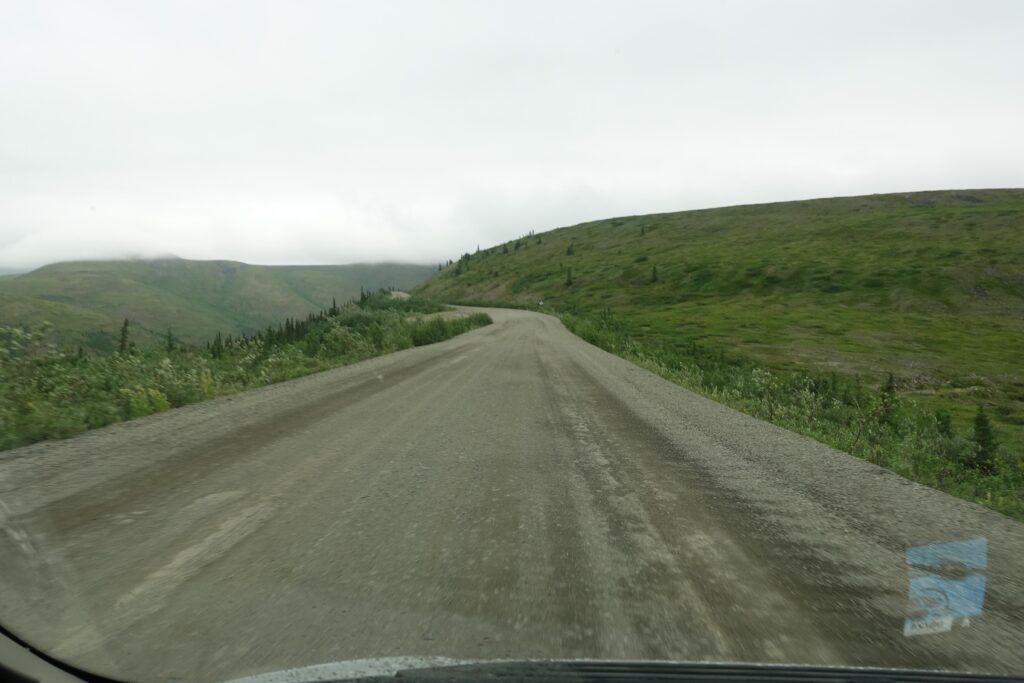

At the border station we stood for about half an hour. We were the only ones there and the border guards were bored. So we were goofing off. I now have a stamp in my passport and can leave and enter the country as often as I want (within 90 days). When I came out of the border station, I noticed that Annie Way was dirty. The gentlemen said that in Alaska almost every campground had pressure washers. By now I was already practiced at it.



The place is not only the border between Canada and the USA, but also between the time zones. Once again, I set my watch back an hour. As of now, I was lagging ten hours behind Austria.
It went on through mountains and valleys, but in total more downhill than uphill. In total, we encountered seven cars on a distance of 270 km. And those only when it had stopped raining.
In Alaska, the weather got better. Not so the road. The most dangerous part was when it was actually paved. But on permafrost the road cracks or sinks. We had to brake hard a few times to avoid plopping into a hole. That would not have done Annie Way any good. And a 20 cm wide, 20 m long and 1 m deep crack in a road … and another and another … No wonder that they had given up on the Canadian side after a first paving attempt. The patterns the cracks drew in the asphalt looked pretty good, though!
At one point, I was actually sitting in Alaska overlooking the mountains, eating vegetable samosas with relish. Delicious! Many thanks to the cook in Dawson! And because it was so beautiful there, I stayed for about half an hour.


From Chicken on it was almost boring. We reached the campground in Tok at 1 p.m. local time, five hours after we had left the ferry in Dawson. Annie Way was unrecognizable.
The first thing I did was to subject her to an extensive high-pressure shower. It cost ten US dollars, but it was absolutely necessary. I also treated myself to a shower afterwards. It cost nothing, but was also absolutely necessary.
As I turned on the stove to make some coffee, I froze for a moment. The propaine worked. On our trip through the mountains, both the safety valve and the valve of the propaine tank had been open. Can someone please explain this to me?

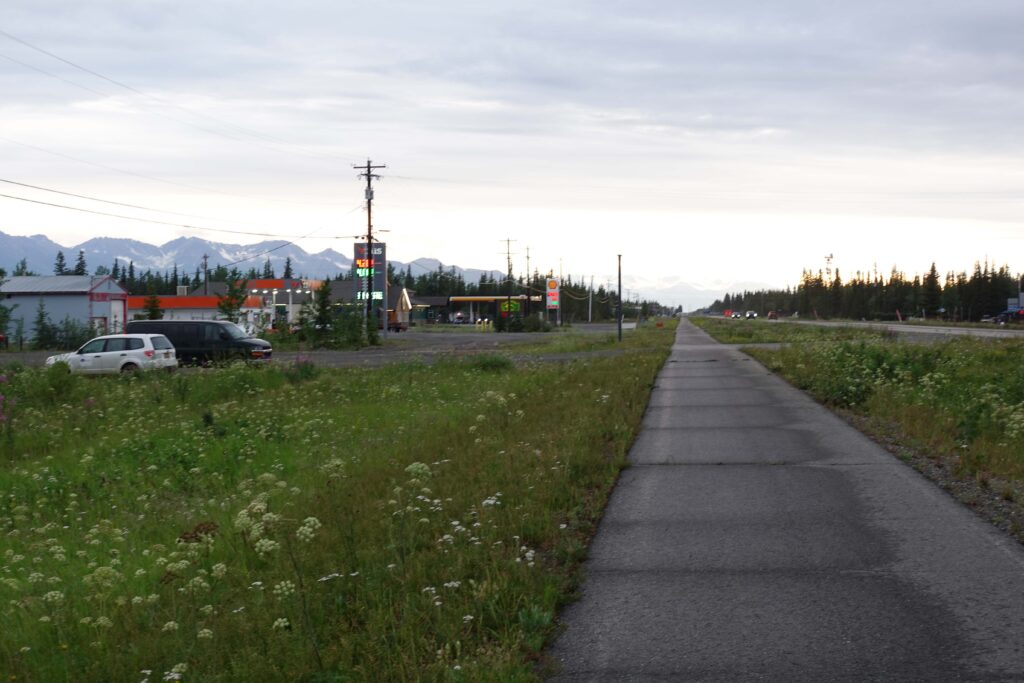
From Tok we were back on the Alaska Highway, which took us to Fairbanks the next day.
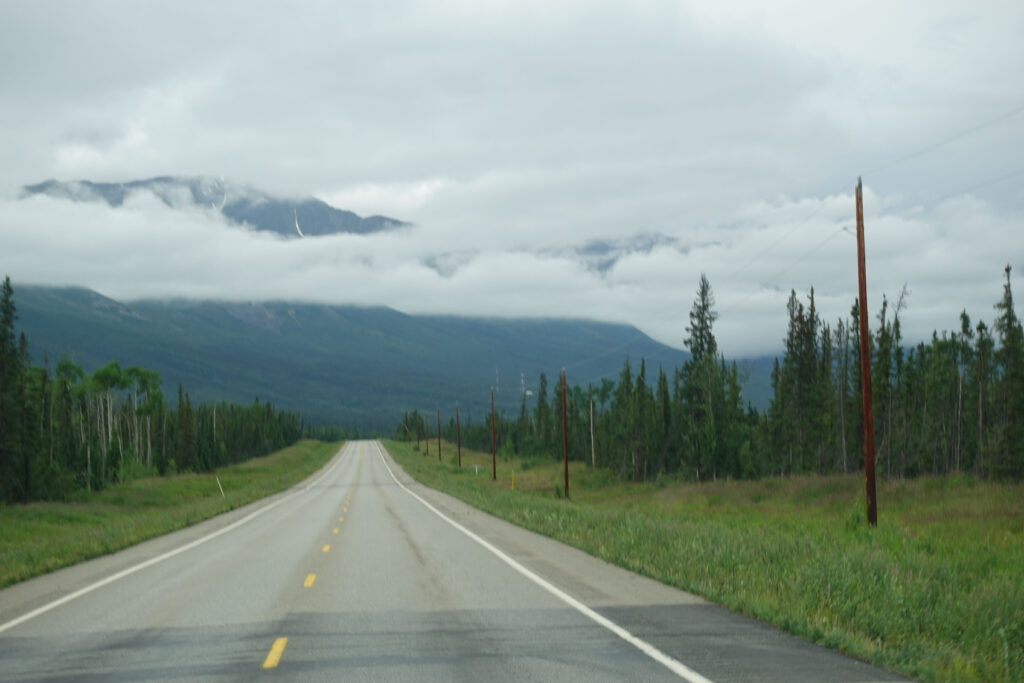






Just outside Fairbanks is the amazing town of North Pole, where it’s Christmas all year round and even the streetlights are striped white and red.

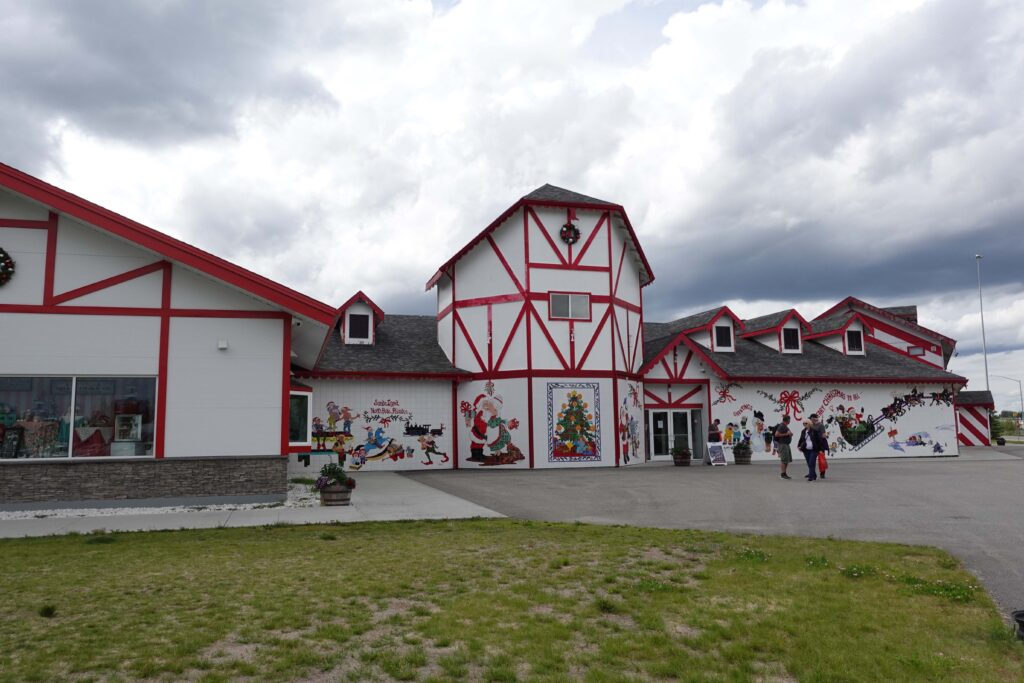
For me, Fairbanks is the northernmost point of my trip. Sunset just after midnight, rise before four o’clock. And the fact that it doesn’t get dark in the time in between is something I’m getting used to.
Before I left for Canada, many people asked me if I had seen the movie “Into the Wild”. Finally, I watched it so I could have a say.
What Alex Supertramp was doing made me angry. He went into the wilderness completely unprepared, without a map. Otherwise, he would have known that there were two ways to get across the river not far from where he stood.
Since the bus in which he lived and eventually died was repeatedly the target of adventurers, which then resulted in search operations that were very dangerous for the rescue teams, and in which two of Supertramp’s successors also died, the vehicle was shipped by military helicopter to Fairbanks in 2020, where it can now be admired in the Museum of the North on the university campus.
Of course, I wanted to take a look at that.
My first exploration into downtown Fairbanks surprised me with a town fair, bouncy castles, and countless booths – they didn’t have to go to that much trouble for my sake!

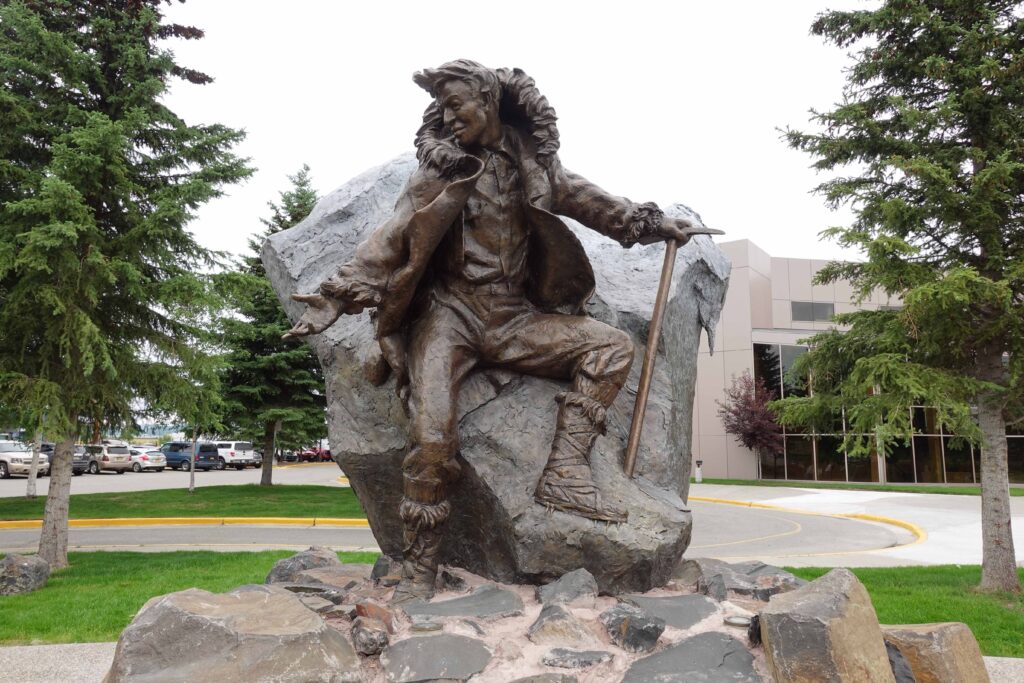


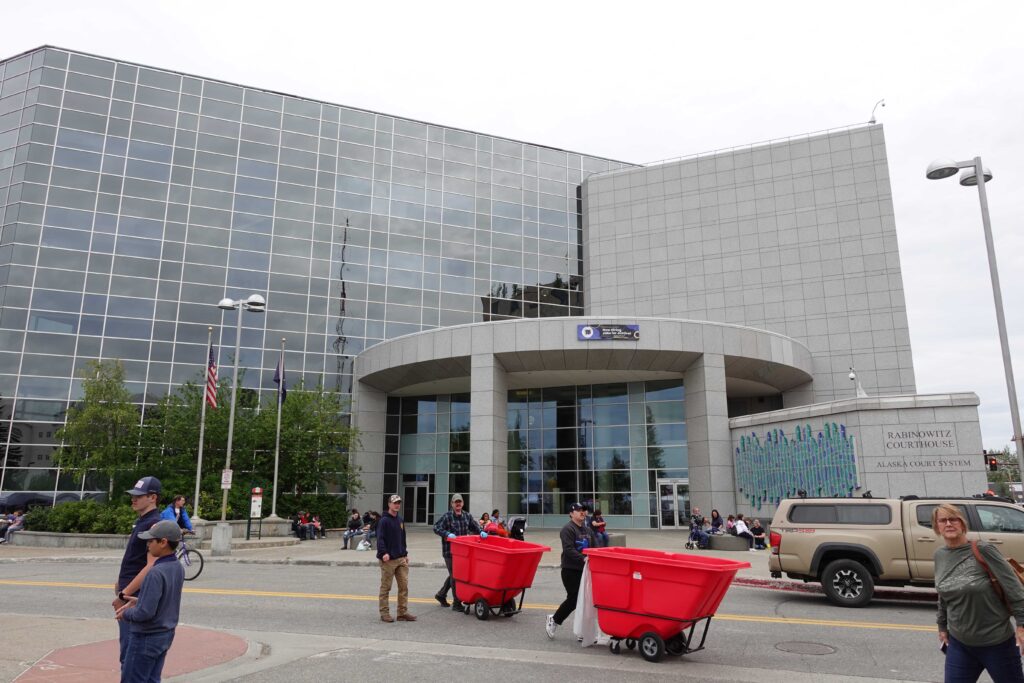

This included the annual Rubber Duck Race, in which 8,000 participating rubber ducks float down the Chena River, propelled by the current and a cheering crowd. At a bridge, a hose is stretched across the river, which on the one hand represents the finish line, and on the other hand conveniently stops the ducks.
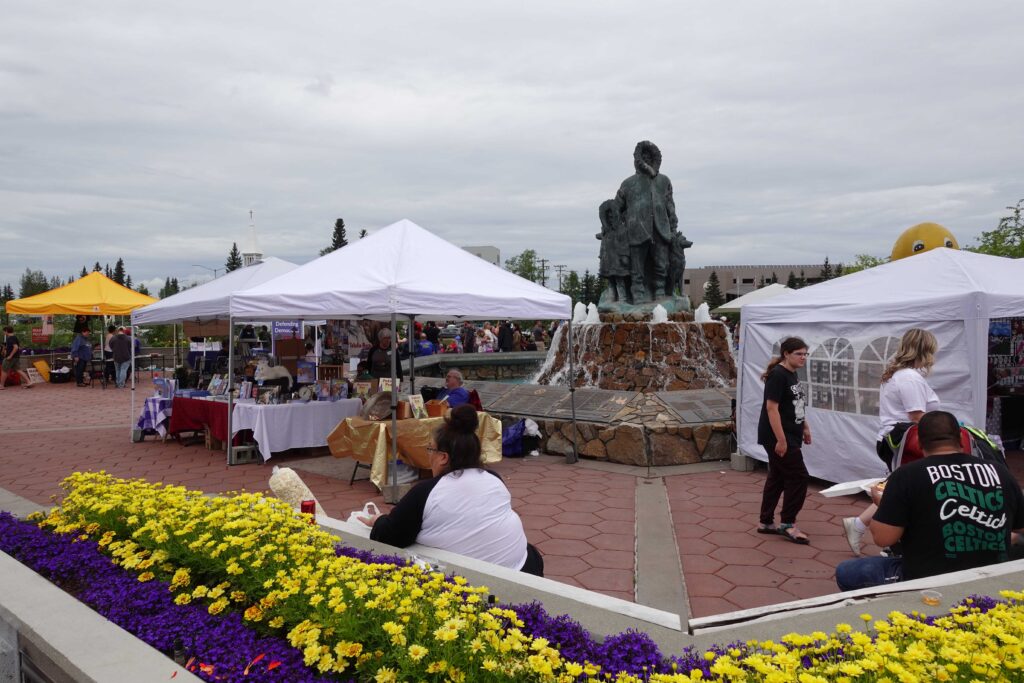



Each duck has a number. Before the race you can draw a number for ten dollars. Whoever wins – or rather, whose duck is the fastest – gets $10,000. Overall, this is a fundraiser for charity. The spectacle lasted no more than twenty minutes, after which the ducks were collected and the crowd was promised: “No duck will be left behind!” – after all, the ducks should not pollute the river. Volunteers searched the riverbank, but most of the ducks had reached the hose anyway.

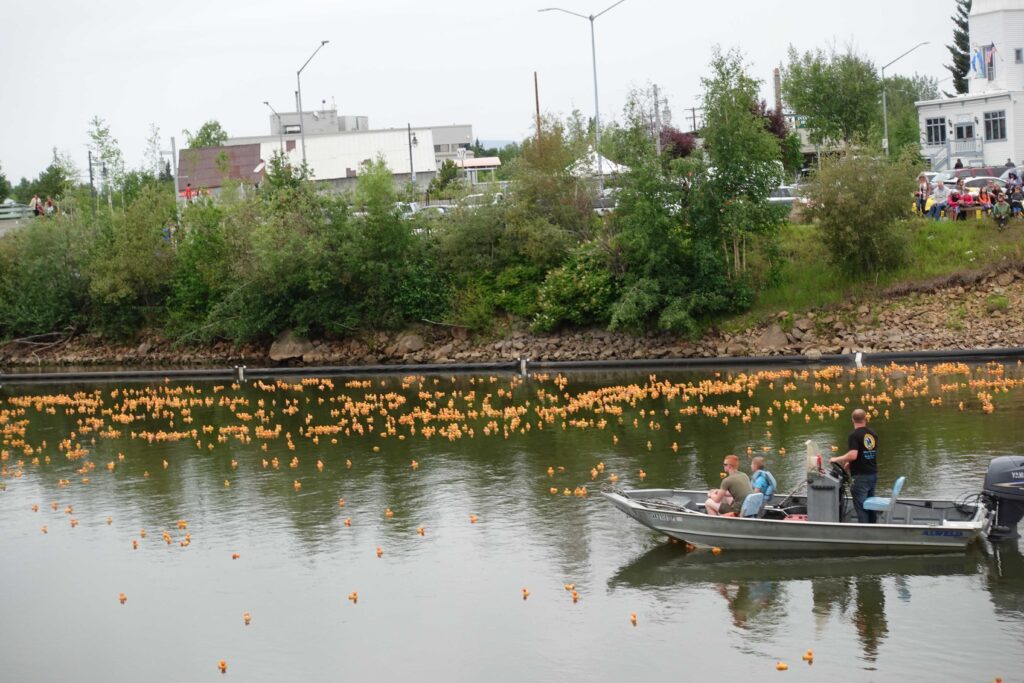


I strolled through the many sales and information booths and visited a mall that has nothing to do with the ones we have in Austria: They were exclusively small stores with local and regional products and a wide variety of offers.
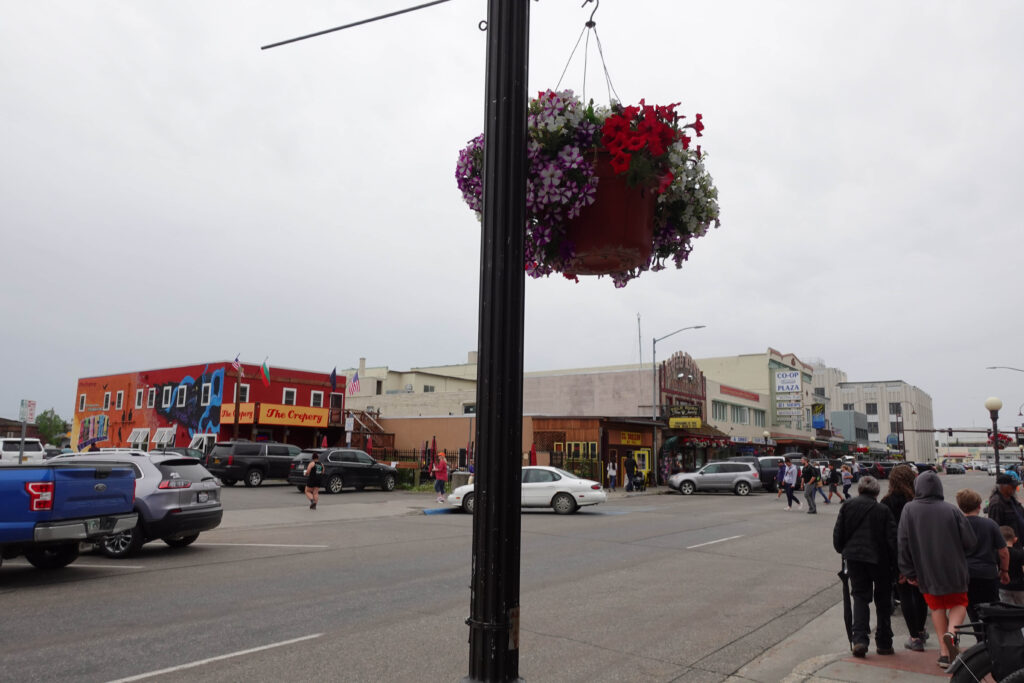

At the Morris Thompson Cultural and Visitor Center I got some information about Fairbanks and Alaska and had a look at an exhibition.
Since I was still not quite fit, that was enough for the first day.


The second day I went to the Museum of the North – great building, located in the university campus on a hill overlooking the plain and the mountains in the background. The first floor was about Alaska’s history, geography, geology, and biology, and the second was about art. Very impressive.
Unfortunately, the university building where “The Magic Bus” is located was closed on Sunday.
I then drove to a musk ox and reindeer research center where they breed the animals and keep them in huge enclosures for research purposes.
Muskoxen were close to extinction, but are now no longer endangered. However, they may be hunted only under very limited conditions. They are more related to sheep and goats than to cattle. Males grow up to 400 kg, females under 300 kg. They reach an age of 20 years. Due to their thick horny armor on the forehead, it can be very dangerous for the animal keepers to work with them. However, you can attract them to the fence with dandelions and birch leaves. May I introduce – Doby and / or Hagrid, but can be anyone else, Ron or Professor Snape for example.


Reindeer were brought to Alaska from Norway in the 1940s to stave off famine. They are the same species as Cariboos. The experiment didn’t work, but now there are reindeer in Alaska.
After the tour of the research station, it was time for my first bulk purchase. I had got into the habit of going shopping about every five days, depending on how much fruit I could get my hands on (organic and Fairtrade aren’t available everywhere). When the fruit was coming to an end, it was time to go shopping again. Or when the Cinnemon Rolls ran out. Or the M&Ms.
In Canada, a purchase including drinks had cost the equivalent of 30 to 40 euros. (I also drink weird stuff like Coke and Sprite here because the store-bought water isn’t really a high point for the taste buds and there’s no tasty diluted juice).
82 US-Dollar! Five organic bananas, kiwis (to get my still rather snuffy immune system going), a few drinks, salad, sweets, lentils, … 82 US dollars. According to the current exchange rate 72 euros.
The fact that the campsites in Alaska are more than twice as expensive as the ones in Canada, doesn’t surprise me anymore.
At least Annie Way’s diesel keeps within limits at just over one euro per liter. The conversion is still a bit tedious with gallons (= 3.8 l), but in a few days it will be automatic. At least the dollar exchange rate is currently at a friendly 0.89. Not long ago, one US dollar was worth more than one euro.
On the last evening in Fairbanks, I sat by the Chena River and watched the sun, which once again refused to set. The northernmost point of my journey. Two and a half months on the road. I was almost overcome by a bit of melancholy. Vanlife is not the way I want to live in the long run, but time passes almost too quickly for me here.
On the other hand, I made it to Alaska. Via the Top of the World Highway. In the rain. Now Denali and Kenai are waiting for me. Homer will be the westernmost point of my journey (if I get there), from there I’m already on my way back … But that’s the goal of every journey: One arrives at some point.
At yourself.
On Tuesday, July 18, the trip to Denali was on the agenda. I got up and found that my cold was gone. No sore throat, hardly any cough, no cold, no stuffy nose, no headache, …
That’s when I remembered the bus. Alex Supertramp. He had starved to death just 30 miles from the entrance to Denali National Park and 25 miles from the nearest town. “Because he was stupid!” said the woman at the campgrounf reception when I asked if she knew how I could get to the building where the bus was now. She did not know.
“Oh, the stupid guy!” someone else commented. Yes.
I fully endorse this opinion.
So once again to the Museum of the North, where I asked for the exact directions. Those who drive to campus pay for parking – except for those who work there. However, buses are constantly passing through the area.
I paid dutifully and shortly after stood in the Engineering Building on Level 2, where the main entrance was located. From there you could see down into a hall on level 1 where they had parked the bus.
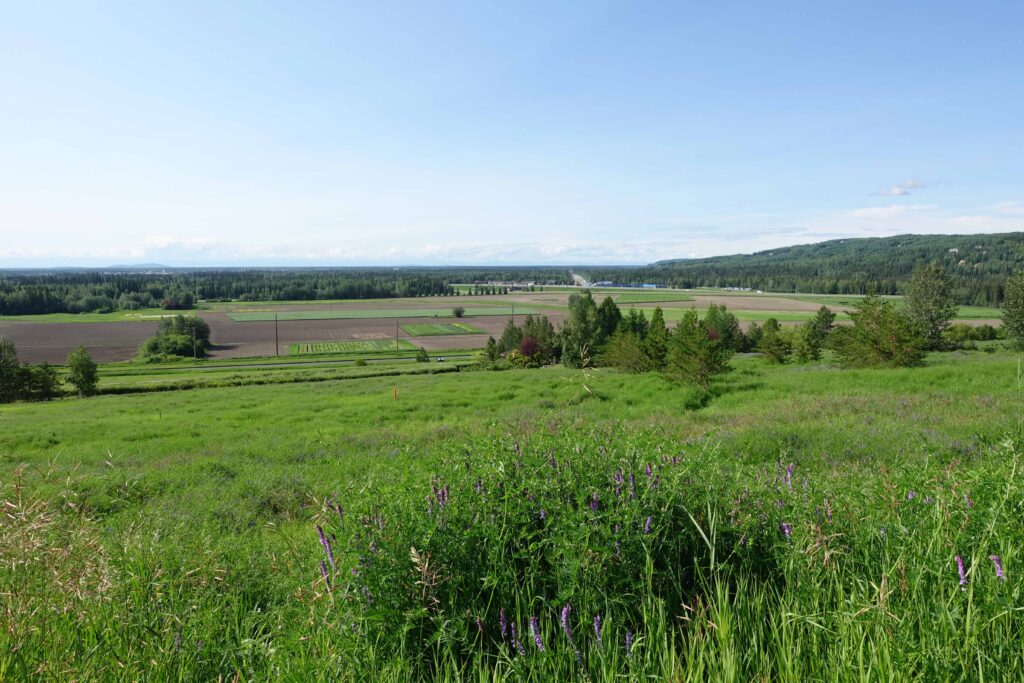
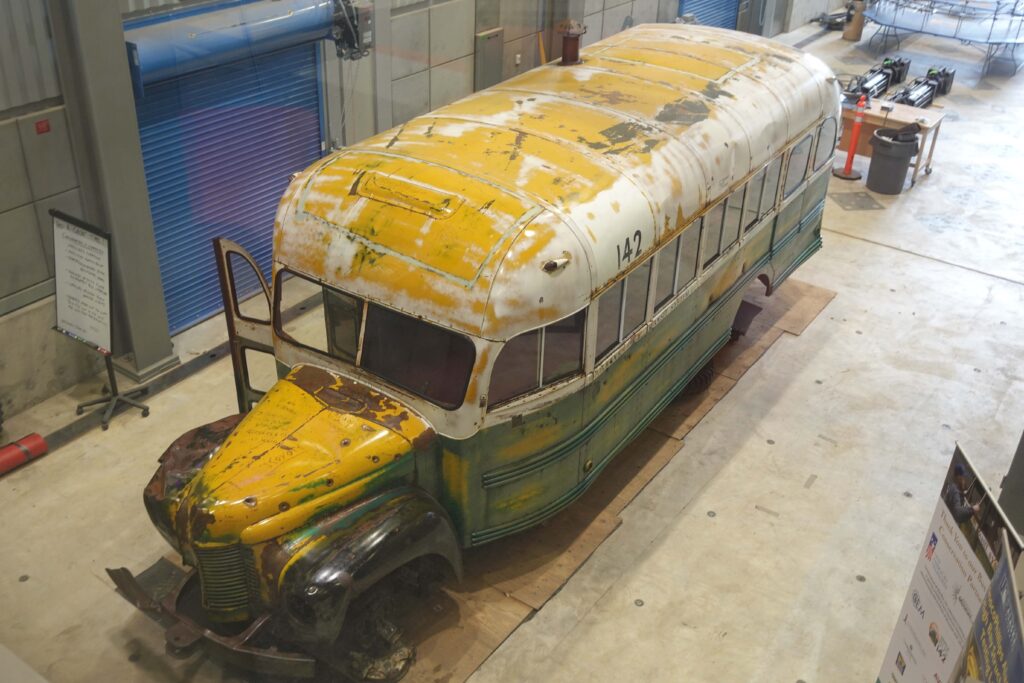
The original bus 142, which had stood lonely and alone in the wilderness for 60 years. Originally put there as a place for workers to stay overnight, it gained notoriety when Alex Supertramp (Christopher McCandless) spent the last three and a half months of his life there and starved to death because he didn’t have a map of the area with him. Otherwise, he would have known that he could have easily gone back even though the Taklanika River had too much water to cross. Just two hours of walking in one direction, the river split into five arms that would have been easy to ford. And an hour’s walk in the other direction there was a basket to sit in and pull yourself across the river on a rope. Both were marked on all maps of the area – as was all vital information for people traveling in the wilderness.
A strange feeling. I stood at the glass window and looked at this vehicle, which was about a hundred years old and had been standing in the middle of nowhere until 2020, when it had gained cult status through the book and especially through the film produced by Jean Penn. The Magic Bus. What a sad sight! Locked between narrow, gray walls! 60 years on a cliff with a view, the sky above. And now everyone was looking down at him.


However, this hall is only a stopover. Students are working to restore it to the point where it can be placed in a more dignified location as an exhibit.
I went back to Annie Way, and we took off. I hadn’t listened to “Playlist Annie Way” in days – after Sally had complained so bitterly. My throat didn’t hurt anymore, but I still didn’t sing along. My voice had to be spared. There are over 300 bears in Denali, and they want to be motivated to run away!
